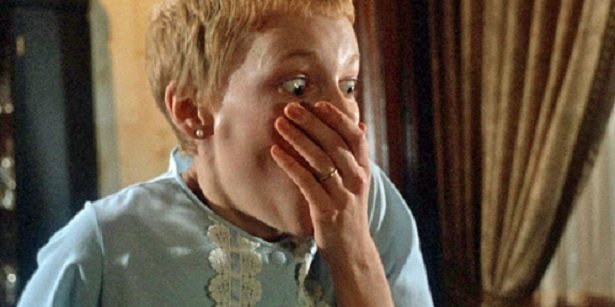Satanic Panic: How Rosemary’s Baby Launched the A-List Horror Movie

Photo courtesy of IMDb #film #horror #movies #writing #review
Rosemary’s Baby (1968) is one of the most influential horror films ever made. It launched a frenzy of Satanic-themed big and small screen productions that lasted from the late 60s to the early 80s. It also launched an entirely new category of film: the A-List horror movie.
Before Rosemary’s Baby, horror was largely a B-list genre. Major horror actors like Vincent Price, Christopher Lee and Lon Chaney Jr. were usually not offered leading roles in mainstream films. Big-name mainstream stars of the 60s, like Paul Newman, Jane Fonda, or Warren Beatty, did not appear in horror productions unless they were either on their way up or on their way down. (Steve McQueen did The Blob (1958) when he was a young unknown.)
There were the occasional exceptions, such as Jack Clayton’s The Innocents (1961), and Hitchcock’s Psycho (1960) and The Birds (1962), but for the most part, horror was the red-headed stepchild of filmdom. It was a steady money-maker, but nobody wanted to hand out Oscars or Golden Globes for the performers, directors, or crew members.
Devil Worship Down the Hall
That all changed after Rosemary’s Baby. Devil-worshipping and witchcraft had long been a staple of B-list horror, but this film was different. It eschewed the long-established conventions of classic horror—there were no dry-ice-produced fog banks, no creepy old castles, no wolves howling at the moon. The witches portrayed in the film, too, were different. They were not German-accented old hags in black robes, but ordinary Americans who lived down the hall and gossipped about menstrual cramps and the price of Sanka instant coffee.
The horror portrayed in Rosemary was almost entirely psychological; it did not depend on bloody masks or severed heads to enthrall the audience.
The actors, also, were different. The main star, Mia Farrow, was a “hot” Hollywood property, especially after marrying Frank Sinatra, the uber-A-Lister of his day. The director, Roman Polanski, was already knocking aggressively at the doors of the top echelon of Hollywood helmsman after only a handful of projects. The supporting cast was full of prestigious names like Ralph Bellamy and Ruth Gordon.
The upshot was that Rosemary’s Baby was a monster hit that brought in audiences who normally wouldn’t be caught dead at a Lon Chaney Jr. or Vincent Price film. The final seal of A-list approval occurred when Ruth Gordon won an Oscar for her portrayal of Minnie Castevet, the gossipy yenta who in the film is co-leader of the coven of witches that bedevils the main character, poor waif-like Rosemary.
The success of Rosemary quickly spawned a legion of imitators on both the small and large screens, ranging in quality from the sublime (The Exorcist) to the utterly absurd (Devil Dog, Hound of Hell--a TV movie from the late 70s about a German Shephard who’s possessed by Satan). Big name mainstream actors and directors were no longer shy about being associated with horror. Oscar-winner Gregory Peck signed up for The Omen (1976), and Oscar-winner William Holden head-lined the sequel two years later.
Significantly, none of these new A-list horror films employed the stars who had been doing horror all along. There were no roles in these films for Price, Lee, Ingrid Pitt, Hazel Court, or Peter Cushing that paid them A-list megabucks. Very likely, they felt pushed aside, especially as the big-budget, mainstream horror film started to eclipse the traditional offerings from Hammer, Amicus, and American International Pictures. Classic horror quietly died sometime in the late 70s--with Hammer closing up shop in 1980--and sadly, few audiences even seemed to notice.
Hello @janenightshade, thank you for sharing this creative work! We just stopped by to say that you've been upvoted by the @creativecrypto magazine. The Creative Crypto is all about art on the blockchain and learning from creatives like you. Looking forward to crossing paths again soon. Steem on!
Thank you!
It's amazing to see what triggers a wave of "me too" imitators, isn't it?
Horror historians link the explosion of the paperback horror market to the success of three novels: Rosemary's Baby, The Exorcist, and The Other, and it's exactly those three movies that drove a stake into the old Hammer and Universal horror pictures.
I didn't seriously enjoy Hammer until I was into my early thirties, and while my library is grossly incomplete, what I have seen has, for the most part, blown me away. Hammer was "going there" years before the other studios were, whether it was with blood or nudity or special effects that are dated but still manage to work. They have their weak entries, as does any producer/distributor from the period, but damn if Christopher Lee, Peter Cushing, Vincent Price, and Ingrid Pitt aren't mesmerizing when they're on the screen no matter the film.
I didn't really have an appreciation for Vincent Price until I watched his old Roger Corman films for my recent article at Horrornews.net. (The Bergmanesque Masque of the Red Death, brilliantly shot by Nicolas Roeg, blew me away.) I'm now working on another list for horrornews of Chris Lee's greatest hits.
With regard to the Satanic Panic film craze, I think it all went back to the youth revolt of the 60s and early 70s. It's significant that the Satanic Big Three -- The Omen, The Exorcist, and Rosemary's Baby -- all feature Satantic children or babies. It was a catharsis for people who felt they were losing control of their own children. In another era, those films may not have been as significant as they were in the late 60s/70s.